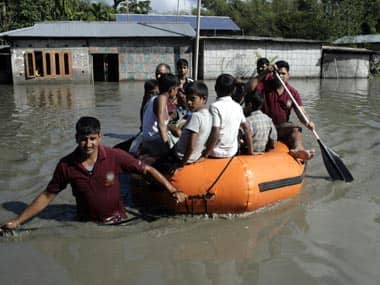Patna: When the mighty Kosi broke its embankment in Kushaha in Nepal and chose to flow in an uncharted route through 2,000 densely populated villages downstream in 2008, it had a devastating impact on North Bihar. Hundreds of people - around 450 according to government estimates and much more if you believe other sources - perished and millions had to be rescued and rehabilitated. This time if the river - known as the curse of North Bihar - does it again the impact could be much worse, say experts. Massive landslides triggered by heavy rains have blocked the stream of Kosi at the site of its origin in Nepal, leading to the formation of a temporary lake. The water deposit in the lake has gone up by an alarming 28 lakh to 32 lakh cusecs. Authorities and exerts fear the Kosi barrage at Birpur in Supaul district bordering Nepal could feel the greatest pressure and may burst if pent up water comes gushing down after it is released. The Nepal army is already carrying out blasts to clear the debris blocking the river stream and the authorities believe an estimated 40 percent of the dammed water could reach Bihar once it is released. If that really happens, this is bound to cause floods in Bihar, the likes of which has never been seen in the past. [caption id=“attachment_1648657” align=“alignleft” width=“380”]  Reuters[/caption] The basis of the state government’s worry is the barrage has been designed to withstand maximum water flow of 9.50 lakh cusecs. Some 15 lakh cusecs of water is likely to reach the barrage once the water is released. The state government has been informed by the Nepal authorities that the water level of Kosi may rise by 10 to 12 meters - the height of a three-story building - once the blockage is cleared. Anticipating the crisis, the state government has now launched the immediate forcible evacuation of some five lakh population settled both in and along the bed of the embankments. “I am not aware what amount of water will come to the barrage but if it happens then several districts can just vanish from the map,” prominent flood expert Dinesh Mishra said. Mishra has conducted research on Kosi and has also wrote a book titled “Trapped! Between the devil and deep water”. He feels if the volume of accumulated water in Kosi is so huge, it is likely that nothing will be left of the 268-km long embankment. According to him, even the best scenario does not look good. “The best scenario is the water gushing down will confine itself to inundating many of the 380 villages that fall between the eastern and western embankments. The worst scenario is the huge amount of water will break embankments on either side of the river and inundate hundreds of villages of north Bihar,” explains Mishra. His logic is not without basis. In 2008, the Kosi had breached its mud embankment at Kushaha even when the water discharge in the river was only 1.66 lakh cusecs. The river again breached bank in 1984 when the volume of water was merely 4.54 lakh cusecs. Similarly, the volume of water was 9.13 lakh cusecs when the western embankment of Kosi gave way in 1968. Obviously, the government is worried. “Once the blockage is cleared, water will gushing down to Bihar plains and may damage our embankments. We just can’t do anything but pray for it to pass,” says Bihar’s Water Resources Minister Vijay Kumar Chaudhary. Bihar Chief Minister Jitan Ram Manjhi is of a similar view. “There is no need for panic right now but who is to say what will happen next if the accumulated water is released suddenly. It will be a deluge. We only hope Nepal will control the downward flow,” said Manjhi. Another expert, Sanjay Pandey, finds the present situation more than alarming saying this is the first time that such a huge lake has got formed in Nepal. “This is purely a new phenomenon. The accumulation of more water with time only increases the danger further and hence it requires extra care to release the water in a controlled way,” he said. The gravity of the situation is underlined by the fact that all the 56 gates of Kosi barrage have been opened to allow the smooth flow of water and the river bed cleared to allow maximum flow of water. The irony of the villagers located in the areas is that they have been fleeing and fleeing, most of the time ending up losing their lives as well as property, right since the barrage was built between 1956 and 1962. Most of the experts now feel the embankments are filled with silt and sand, and a little increase in the water level is bound to cause heavy damage to both life and property. The prevailing situation has revived fears of a repeat of Kushaha-like disaster or even worse.
Patna: When the mighty Kosi broke its embankment in Kushaha in Nepal and chose to flow in an uncharted route through 2,000 densely populated villages downstream in 2008, it had a devastating impact on North Bihar. Hundreds of people - around 450 according to government estimates and much more if you believe other sources - perished and millions had to be rescued and rehabilitated. This time if the river - known as the curse of North Bihar - does it again the impact could be much worse, say experts.
Advertisement
End of Article


)

)
)
)
)
)
)
)
)



